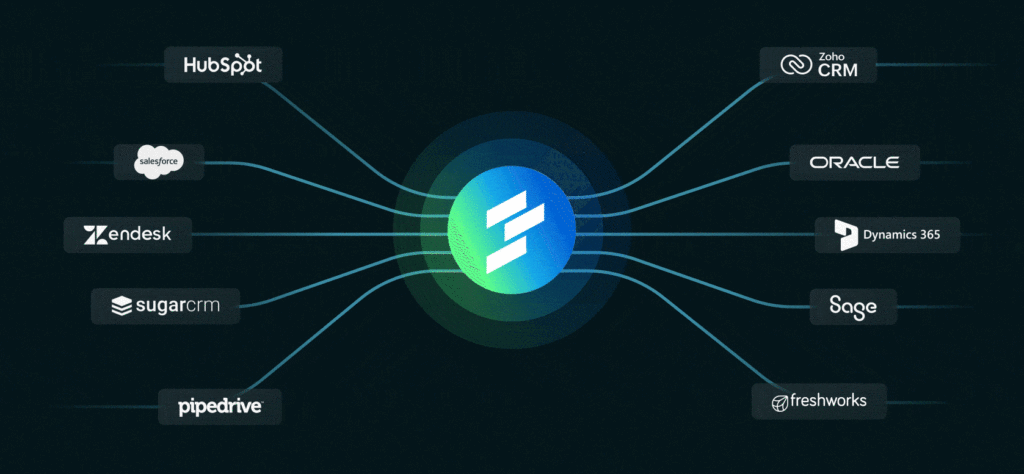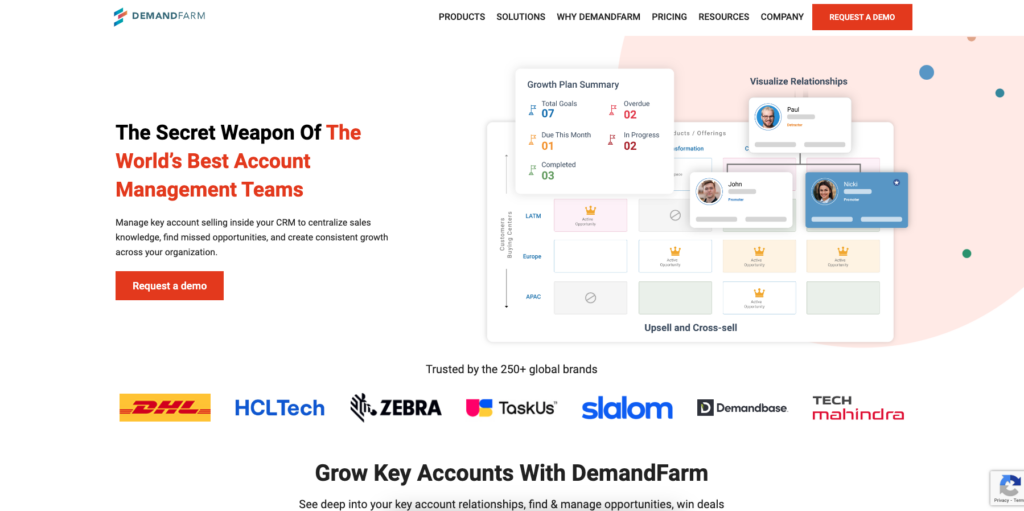How TrendyMinds identified 50% more upsell and cross-sell opportunities in their key accounts

Discover how TrendyMinds transformed unpredictable revenue into predictable growth by adopting DemandFarm. Faced with a reactive approach, scattered data across multiple tools, and poor visibility, TrendyMinds sought a solution for their key account planning. With DemandFarm, they implemented a systematic, unified approach to account planning, relationship mapping, and forecasting directly within Salesforce. This led to full end-to-end visibility, proactive engagement, and significant efficiency gains, freeing up client partners from tedious manual work. The results are compelling: a 14x increase in strategic account reviews per account and a 2x increase in total opportunities Read the full case study to see how TrendyMinds moved from relying on luck to building a structured system for predictable success. Access the case study here >>
AI in Strategic Account Management: Too Human to Scale, Too Complex to Automate

AI excels in lead generation with abundant external data. But key account management demands inside-out intelligence like tribal knowledge, intent signals, and relationship dynamics that exist nowhere in public databases. But only 12% of organizations believe their key account data is highly structured and usable by AI, while 1 in 3 strategic accounts are lost due to stakeholder visibility gaps. With $2.7M average revenue exposure per strategic account, the margin for error is razor-thin. As Gartner notes, “AI is only as smart as the institutional memory it inherits.” Yet most KAM intelligence lives in PowerPoint decks, Slack threads, and departed team members’ heads, making AI implementation futile. Assessing your data foundation is essential before implementing AI in your KAM strategy. This approach will help you: Evaluate your current KAM data structure and intelligence systems Transform tribal knowledge into systematic, AI-ready processes Build the intelligent foundation that moves from reactive firefighting to proactive acceleration Read the whitepaper on AI in Key Account Management and discover how to build the data foundation that makes meaningful KAM AI possible. And, discover how DemandFarm’s KAM AI analyzes account dynamics, predicts relationship risks, and recommends strategic actions to accelerate your KAM goals.
Why AI in Key Account Management Is Useless Unless…

AI has swept across the enterprise. From marketing automation to customer support, from predictive lead scoring to content generation—every function is being reimagined by intelligent systems. The logic is simple: train the models, refine the data, automate the process, and scale. But this linear formula doesn’t quite hold in key account management (KAM). AI’s promises feel premature, disconnected, and sometimes out of context in KAM. And that’s not because KAM is behind the curve. It’s because KAM is still driven by human complexity that AI cannot replicate—at least not yet. Strategic account growth depends on trust built over years, understanding of internal power structures, shared institutional history, and relationship intelligence that often isn’t written down. In most organizations, the real insights live in human minds, whiteboard scribbles, Slack threads, and exit interviews—not structured CRM fields. Which means that AI, no matter how powerful, has almost nothing to learn from. The Hidden Cost of Being “Too Human” Veteran account managers navigate complex buying committees, shifting priorities, and nuanced organizational cultures by relying on instinct. These instincts are priceless but also inherently unscalable. What one senior manager knows after ten years in a single account rarely makes its way into the hands of the broader team. There is no institutional memory, no pattern recognition, no data trail for AI to latch onto. And so, while every other function in the enterprise gets a tech upgrade, KAM remains high-touch, manual, and dependent on the same people. It’s like asking AI to pilot a plane mid-storm without access to any flight data. The system might be intelligent, but it’s blind. This is where the cost of being “too human” reveals itself. Decisions remain tribal. Knowledge stays local. Growth becomes fragile. And when those senior managers leave, they don’t just take their contacts—they take the map. AI in Lead Gen vs. AI in KAM Why AI succeeds in lead gen but might not be efficient in KAM. Here is why. Lead generation is an AI playground. Public data abounds: job titles, firmographics, intent signals, content consumption patterns. You can model buyer journeys, automate email sequences, predict timing, and even write the perfect cold message. And if the AI gets it wrong? You lose a few leads. It’s a recoverable mistake. But KAM operates in an entirely different paradigm. You’re not casting a wide net. You’re safeguarding multi-million-dollar relationships that took years to build. The risks aren’t just financial—they’re strategic. Losing one key account can mean stalled product adoption, delayed expansion, or reputational damage in the C-suite. You don’t just lose revenue. You lose momentum. Which is why the AI models that power outbound engines fail in key account growth. The variables in KAM aren’t public. They’re personal. The real data isn’t found in firmographics—it’s found in relationship dynamics, unspoken goals, evolving priorities, and quiet power shifts. And without that intelligence, AI is just guessing. KAM Skipped the Maturity Curve Most tech categories follow a logical arc: first, systematize the process. Then, standardize it across the organization. Only then do you automate. CRM followed this path. So did marketing automation. Even customer success tools took a decade to reach maturity. KAM, on the other hand, skipped steps. In the rush to modernize, teams jumped from post-it notes to predictive analytics—without ever building the structured systems in between. There’s an unspoken assumption that AI will figure it out. But AI is not magic. It can only learn from what exists. And if your goals, relationships, and conversations only live in PowerPoint decks or managers’ memories, there is nothing to train on. This mismatch between ambition and foundation is why most “AI-powered” KAM tools feel underwhelming. They promise transformation, but deliver alerts no one trusts and suggestions no one uses. Inside-Out Intelligence Is the Missing Layer What KAM truly needs isn’t more automation. It needs intelligence—but not the kind you can scrape from LinkedIn or synthesize from press releases. KAM needs inside-out intelligence: signals captured within your business, from the conversations your teams have, the goals your clients set, the shifts in influence, and the history of engagements that unfold over time. Think of it this way: most sales AI is a telescope—it looks outward. But KAM AI must be a microscope. It must examine what’s already happening inside your strategic accounts and make sense of it. What are the patterns from past goal failures or successes? Which relationships are weakening? Which internal stakeholders are blocking expansion and why? Where does whitespace keep showing up but never convert? These questions cannot be answered by public data. They require an internal data layer—structured, logged, and ready for intelligent systems to analyze. And that layer, for most teams, doesn’t exist yet. The Paradox: Too Human, Not Enough Wisdom Here lies the central contradiction. KAM is rich in wisdom—but poor in data. Every conversation, insight, and decision is drenched in context. But none of it is captured systematically. So when organizations look to AI for help, they’re essentially asking it to scale tribal knowledge without first documenting it. This is why AI in KAM often feels tone-deaf. It delivers generic suggestions because it lacks access to account-specific history. It proposes playbooks without understanding the nuances of a particular buyer relationship. And it fails to anticipate risk—not because it’s unintelligent, but because it was never fed the right signals. The problem isn’t AI. The problem is what we’ve failed to preserve and structure. Why External Data Won’t Save You It’s tempting to think that buying intent tools or hiring better enrichment platforms will bridge the gap. But external data has diminishing value as soon as an account becomes strategic. That’s when you need to know: Who truly influences decisions? Which relationships are active, dormant, or in decline? What motivates your champion’s internal narrative? Which internal shifts are impacting deal momentum? These insights aren’t inferable from external feeds. They live in your meetings, emails, call notes, and rep memories. Which means you can’t outsource your way into account intelligence. You have to
2025: The Year Key Account Management Becomes Omniscient

“A relationship, I think, is like a shark. It has to constantly move forward or it dies.” — Woody Allen, Annie Hall Key Account Management has always been built on a foundation of intuition backed by the wisdom from innumerable conversations, and strength of human relationships. Revenue success has always hinged on the ability to read between the lines, sense the unspoken, and navigate the invisible currents of organizational power with experience-honed instincts. The best Account Managers in the world have always had an innate ability to detect what’s happening beneath the surface. They could read human emotions, organizational shifts, and the subtleties of stakeholder dynamics. From Digital Execution to True Intelligence: The Evolution of Account Management For decades, account management solutions has focused on digital transformation—moving scattered processes, spreadsheets, and presentations into structured digital systems. The early 2000s saw the first wave of solutions, mostly templated methodologies wrapped in advisory services. These were not products in the true sense but structured playbooks that evangelized proprietary models rather than offering real intelligence. By the 2010s, KAM platforms evolved beyond templates. They began capturing various aspects of an Account Manager’s workflow—tracking relationships, mapping influence, and structuring engagement strategies. Yet, despite their advancements, they remained execution tools. They digitized workflows but could not fix the intelligence layer on top of intuition. The Missing Piece: Why the Intelligence Layer Was Never Fixed The last two decades saw incremental progress, but the last two years have brought a transformation unlike anything before. AI is poised to rewrite the very foundation of intelligence in account management. For the first time, AI has a real shot at being truly intelligent! It will amplify human decision-making, spot patterns beyond human perception, and eliminate the blind spots that intuition alone could never fully overcome. This isn’t an evolution. It’s a transformation powered by AI. And it’s happening now. 2025 marks the year Key Account Management begins its transition to an unprecedented level of intelligence and foresight, paving the way for an Omniscient KAM in the future! AI in KAM as an Amplifier, Not a Replacement Gone are the days when Account Managers painstakingly created relationship maps, pieced together fragmented data, and relied on tribal knowledge to assess account health. AI in account management is transforming beyond being a system of record—it is on the path to becoming an active participant in decision-making, operating at a level above traditional intelligence. In the near future, AI will not just record data; it will synthesize, interpret, and act upon it across an organization’s entire tech stack: Structured CRM entries (pipeline status, deal movement, key contacts) Unstructured meeting transcripts (Gong, Chorus, recorded conversations) Conversational repositories (email, chat interactions, sentiment analysis) Transactional data (pricing configurations and discount structures in CPQ systems, approval workflows and contract adjustments in Quote-to-Cash processes, purchasing patterns and vendor negotiations in procurement systems) Soon, AI won’t just detect sentiment changes or unspoken hesitation—it will contextualize them against historical account behaviors, competitive pressures, and broader industry shifts. The Account Manager of tomorrow will have a complete, real-time view of their accounts that extends far beyond what is visible today. With agentic conversations—query-based AI assistance—Account Managers will be able to: Ask AI who to follow up with before key opportunities slip away Get notified about clients showing early churn signals—before they become a risk Detect subtle, unspoken concerns in meeting transcripts, before they escalate Have AI automatically set up follow-up meetings based on past interactions This future is fast approaching. AI will soon move beyond today’s “play fetch” phase—where it merely retrieves information—to a state where it analyzes, anticipates, predicts, and recommends actions. It won’t just flag an account’s lukewarm response in a call or detect a subtle shift in tone—it will correlate those signals with historical interactions, stakeholder movements, and transactional patterns to reveal what they truly indicate. More importantly, it will prescribe the next best action—whether to intervene, re-engage, or escalate—to retain, manage, and expand key accounts. And while we may not be fully there yet—we are closer than ever before. Why This Shift Is Happening Now Every fundamental shift in human history follows a pattern. First, we rely on raw human effort, experience, and the unstructured dance of trial and error. Then, we build tools to extend our reach, sharpen our senses, and make the invisible visible. And finally, we arrive at a moment when the tool does more than assist us—it changes us. The printing press did not just make books cheaper; it restructured society around knowledge. The internet did not just connect people; it rewired how we work, learn, and communicate. Now, AI is doing the same for business relationships. The Writing on the Wall! Salesforce, the $340 billion titan of CRM, has made its move. They’ve integrated Key Account Management into their core offerings, proving that traditional strategic accounts management is no longer enough. It’s not just an addition but an admission by the tech-giant. It also proves… The need for companies to explore, invest and measure their KAM stance (before it is too late) That data-driven intelligence is driving KAM success. The traditional KAM playbook is not just evolving; it’s being rewritten in real time. While Salesforce’s entry into AI-powered KAM validates the market shift, true relationship intelligence goes beyond CRM. 2025 belongs to those leveraging deep, integrated insights rather than surface-level automation. Here are the 4 major shifts that will happen in 2025. AI as the Central Nervous System of KAM Brain Unlike traditional KAM based on CRMs, which merely automates processes and logs data, advanced KAM tools powered by AI will move beyond structured data, incorporating unstructured insights from meetings, contracts, and stakeholder discussions to uncover opportunities and risks that have previously gone unnoticed. This will translate to: A relationship intelligence engine that will map power dynamics and hidden sentiment shifts. A living strategy framework that can replace outdated, static account plans. A blind-spot eliminator to surface unseen risks and overlooked opportunities. 1. The Rise of
9 Best Salesforce Apps You Must Have in 2025 to Unlock Enterprise Revenue Growth

Salesforce is the world’s #1 CRM platform—and for good reason. With over 150,000 organizations relying on it globally and $31.25 billion in annual revenue, it’s the backbone of how enterprises expand revenue from their strategic accounts, manage customer relationships, and drive scalable growth. But here’s the thing: Salesforce’s real power kicks in when you plug into its broader ecosystem. The best Salesforce apps on the AppExchange turn your CRM into a complete operating system for sales, marketing, operations, and customer success. Still, with thousands of apps available, choosing the right ones isn’t easy. This guide cuts through the noise. Whether you’re a growing nonprofit or a global GTM team, these are the best SFDC AppExchange tools to unlock speed, intelligence, and strategy in 2025. Top Key Account Management Applications 1.DemandFarm – Best for Strategic Account Management Use case: Managing strategic key accounts with repeatable, scalable revenue strategy Salesforce Appexchange Apps by DemandFarm: DemandFarm Account Management & Planning App for Salesforce(Enterprise) Org Chart – Relationship Map & Organization Chart App for Salesforce (Native) DemandFarm Opportunity Planner – Opportunity Management & Planning App Account Planner Agentforce Extension: AI Account Planning Agent for Salesforce If your biggest accounts still live in spreadsheets, you’re leaving revenue on the table. I’ve seen this play out across multiple teams. DemandFarm fixes that. It’s a 100% Salesforce-native app built to help you scale key account management (KAM) without losing the nuance of high-touch selling. Build multi-year account plans that link to pipeline and revenue Map white space across regions, products, or business units Visualize org charts and track influence and blockers Align seamlessly with MEDDPICC, Challenger, or your custom methodology DemandFarm doesn’t feel like an add-on. It feels like the KAM layer Salesforce always needed. If you’re serious about expanding wallet share, this is your toolkit. 2. DevOps & Release Management: Shipping with Confidence, Not Caution When your CRM is mission-critical and tied to revenue operations, even a small slip can have the snowball effect. That’s why DevOps should prioritize about stability, auditability, and clarity along with agility. These are the three best SFDC AppExchange tools to streamline release cycles, eliminate manual guesswork, and make Salesforce updates feel less like a leap and more like a glide. 1. Copado – Automate Everything, from Planning to Production If your team runs complex workflows and needs governance baked in, Copado is your DevOps backbone. It’s built to unify the full release cycle—from story creation to deployment—with security and compliance in every step. Set up end-to-end CI/CD pipelines across teams Automate testing and deployment while staying audit-ready Control changes with role-based access and version traceability Copado shines in organizations that treat DevOps like a product, not a patchwork. 2. Gearset – Git-Level Control for Non-Git Teams What people love about Gearset is how it simplifies technical workflows without dumbing them down. It compares metadata in real time, flags conflicts, and gives you the confidence to deploy without second-guessing your environment. Instantly diff sandbox and production environments Run pre-deployment validation to avoid surprises Roll back changes if anything doesn’t go to plan It’s the perfect fit for Salesforce teams juggling frequent releases with limited room for error. 3. Prodly – DevOps for Admins and AppOps Heroes Prodly is the tool that lets your admin team play DevOps without writing code. It’s purpose-built for handling data-heavy updates in apps like CPQ or Billing, where config is just as complex as code. Move data safely between orgs using pre-built templates Set up no-code pipelines to handle routine tasks Log every change for accountability and rollback Prodly feels less like a technical tool and more like a productivity multiplier for Salesforce operations. If your business depends on Salesforce but your releases still feel risky or manual, this DevOps stack is where I’d start. It helps your team move fast—but with the confidence that nothing will break along the way. Conversational AI & Lead Engagement: Turning Visitors into Pipeline, Instantly Web forms still exist, but in 2025, they’re not where deals begin. High-intent buyers don’t wait around—they expect answers, context, and relevance in real time. If your site doesn’t deliver that, they’re gone. That’s why conversational AI isn’t a nice-to-have anymore. The best Salesforce-native chat tools sync with your CRM, qualify leads on the fly, and alert your reps when it’s time to jump in. These are the ones to transform your inbound velocity in no time. 1. Qualified – Your Real-Time Conversion Engine Qualified doesn’t just pop up a chatbot—it becomes your AI-powered SDR, always on, always listening. When someone worth talking to lands on your site, it knows. It starts the right conversation, qualifies the lead, and passes everything to Salesforce without skipping a beat. Detects visitor intent based on behavior and CRM data Starts human-like conversations to uncover buyer needs Routes qualified leads instantly to sales, enriched and ready 2. Drift (Now Salesloft) – Conversational Marketing That Feels Personal Drift was one of the first to flip the funnel, starting with conversation, not conversion. It routes based on behavior, pulls CRM insights into the dialogue, and knows when to switch from bot to human without losing the thread. Lead routing and segmentation powered by real-time context AI-driven playbooks that adapt mid-conversation Deep Salesforce integration for personalized follow-ups 3. Intercom – Unified Conversations Across Sales, Support, and Success If you’re balancing multiple touchpoints—across teams, channels, and funnels—Intercom brings it all together. It lets your team manage sales, support, and onboarding conversations from one shared inbox, while pushing every interaction back to Salesforce. See the full CRM profile of every visitor, right in the chat Trigger proactive messages based on lifecycle stage or behavior Scale with bots, then hand off to reps at the right moment Customer Service: Capture Intelligence Beyond the Ticket Customer service is the feedback engine, and feedback is fuel for product, marketing, and revenue. When these insights live inside Salesforce, you gain a single source of truth for how your customers feel, where they struggle, and how
The Best org chart software for large companies

Have you ever walked into a company’s headquarters and seen a wall filled with employee photos, names, and titles connected by lines that map out who reports to whom? That’s an organisational chart, and while it might look straightforward, creating and maintaining one in a workplace can be anything but simple. Imagine you’re a key account manager at a multinational corporation. Your day-to-day involves navigating complex client organizations, each with its own layered hierarchy and network of decision-makers. One of your biggest challenges? Keeping track of who influences which decisions and understanding the power dynamics within these organizations. This is where robust organizational chart software becomes indispensable. These tools are crucial for visualizing corporate structures and strategic account management. They help you identify key players, understand reporting relationships, and tailor your engagement strategy accordingly. In this blog, we’ll explore the top organizational chart software of 2024, focusing on its features, usability, and how it caters to key account managers like you. Whether part of a small firm or a large enterprise, you’ll find insights on choosing a tool that enhances your strategic account management capabilities. What is Org Chart Software? Organizational chart software is a digital tool designed to help create, maintain, and display the structure of an organization. This type of software goes beyond merely showing who reports to whom; it encompasses a range of features that visualise the relationships and hierarchies within a company. It lays out who is in charge of whom, from the executive level down to rank-and-file employees. This is essential not only for new employees getting to know their colleagues and who they will report to but also for senior management to assess the efficiency of their current structures. For key account managers, org chart software is particularly valuable. It can be used to map out the structure of a client organization, identifying key stakeholders and the relationships between them. This strategic insight allows account managers to effectively tailor their approach, ensuring that they engage the right people at the right time to strengthen relationships and maximize opportunities. The Best Org Chart Software of 2024 1. DemandFarm DemandFarm is particularly noted for its functionality in key account management alongside its org chart capabilities. It automates the creation of org charts from existing data, which helps in saving time and improving accuracy. It’s an excellent choice for large enterprises that manage numerous complex relationships across different departments and geographies. Integration with CRM Systems DemandFarm’s integration allows key account managers to access and visualize complex client hierarchies directly within their usual CRM interface, enabling them to manage client relationships more effectively. For example, when changes occur within a client’s organization, these are reflected in real-time in the org chart, providing account managers with up-to-date insights. Strategic Account Planning Tools Managers can use these tools to identify key influencers and decision-makers within client organizations, track communication histories, and set relationship-building strategies. This holistic view supports account managers in making informed decisions that align with both the client’s and their own company’s strategic objectives. Enhanced Collaboration Features DemandFarm promotes collaboration among team members, which is crucial for managing large accounts that require input from various departments within an enterprise. It allows team members to share insights, update information in real-time, and collectively strategize on account management approaches. Key Features: Robust integrations: Two-way sync with customer relationship management tools to provide dynamic insights on client organizations and also with sales intelligence tools to help populate customer data more seamlessly. Customizable Views: Tailor views to display relevant information such as contact details, sales opportunities, and more. Intelligent contact management: Suggests contacts based on priority, influence, and relevance from sales intelligence tools to aid in efficient org chart building. Limitations: Might be more extensive than needed for smaller organizations or those without a focus on key account management. 2. Lucidchart One of Lucidchart’s most significant features is its real-time collaboration capability. This allows multiple users to work on the same chart simultaneously from anywhere in the world. Each change is instantly visible to all participants, ensuring that everyone is always working with the most current data. This feature is particularly beneficial for remote teams or organizations with multiple locations, as it supports seamless communication and decision-making processes. Lucidchart is primarily designed as a diagramming and visualization tool rather than a dedicated account management platform. It lacks features specifically tailored for key account management, such as tracking client interactions, managing sales pipelines, or integrating deeply with CRM systems to provide actionable insights specific to key accounts. While Lucidchart integrates with platforms like Salesforce, these integrations are more about visualizing data rather than enhancing the CRM’s functionality concerning account management. The tool is great for creating organizational charts and mapping relationships, but it does not offer specialized functionalities such as sales forecasting, account health scoring, or opportunity identification that are crucial for key account managers. Key Features: Real-time Collaboration: Multiple users can edit diagrams simultaneously. Extensive Integration: Compatible with platforms like Google Workspace, Slack, and more. User-friendly Interface: Intuitive drag-and-drop functionality. Limitations: Some advanced features are locked behind higher pricing tiers. 3. Microsoft Visio Visio is particularly favored by professionals who require a high degree of customization and integration with other Microsoft products. Visio offers a wide range of diagramming tools that enable users to create detailed, precise diagrams. These tools include a vast array of shapes, templates, and drawing options that can be used to craft everything from simple org charts to complex process maps and floor plans. Visio integrates seamlessly with Office 365 and other Microsoft applications as part of the Microsoft ecosystem. Visio is excellent at diagramming and creating visual representations, but it does not integrate naturally with CRM systems in ways that are beneficial specifically for KAM. While it can be used alongside CRM systems to map out organizational structures visually, Visio does not handle CRM functions such as tracking interactions, managing sales pipelines, or providing insights based on customer data that are crucial for effective account management.
A Comprehensive Guide to Relationship Management

Effective relationship management transcends mere customer satisfaction—it’s a strategic endeavour that involves nurturing deep connections that foster loyalty, satisfaction, and mutual growth. For a sales team, relationship management is essential in nurturing potential customers and onboarding new clients, and utilising effective customer communication techniques, such as consistent and reciprocal communication, can help achieve this. CRM technology, such as Salesforce or Hubspot, can also aid in automating various sales tasks and maintaining positive relationships with potential customers through the use of marketing materials and organized data sets. Good relationship management, with the help of effective CRM software in India and marketing automation, can also help attract and retain new customers, suppliers, and partners, making it a valuable tool for businesses looking to improve their client experience and grow and expand through lead management tool and human resources best practices. The global Customer Relationship Management market is projected to grow from $71.06 billion in 2023 to $157.53 billion by 2030, at a CAGR of 12.0%. In this guide, we will explore various tools and techniques used in Customer Relationship Management (CRM), define the responsibilities of a relationship manager, relationship management techniques, and the tangible benefits that effective relationship management can deliver. What Is Relationship Management with an Example? Relationship management is the systematic approach to maintaining and improving relationships with key stakeholders, clients, or customers. It focuses on understanding and addressing the needs of these groups to build a strong, productive foundation that supports both parties’ growth. Let’s look at an example, Salesforce is known for its customer relationship management (CRM) software but also its relationship management with corporate clients. Salesforce excels in B2B relationship management by providing highly customizable solutions that cater specifically to the business needs of its clients. This personalized approach helps clients optimize their operations, marketing, and customer service strategies through Salesforce’s platforms. For example, Salesforce works closely with businesses to implement CRM systems that integrate seamlessly with existing client workflows and data systems. This level of customization and support ensures that clients can maximize the use of their products, thereby enhancing their productivity and efficiency. Types of CRMs for Different Relationship Management Techniques Customer Relationship Management (CRM) systems are crucial for effective relationship management. They help organize, automate, and synchronize all facets of customer interaction. CRM systems are categorized into three main types: Operational CRM This CRM type automates everyday business processes like sales, marketing, and customer support. An operational CRM can streamline customer interactions to ensure they are efficient and effective, as seen in companies like Zappos, which uses CRM to enhance customer service and speed up response times. Zappos is known for its exceptional customer service. Zappos utilizes operational CRM to manage customer interactions from initial contact through post-sales support, ensuring that every step is handled quickly and efficiently. This system helps Zappos track customer queries, manage orders, and provide timely responses, thereby boosting customer satisfaction and loyalty. Analytical CRM These systems are focused on analyzing customer data and behaviors to draw insights. These insights help businesses understand customer needs and tailor their marketing efforts accordingly. Netflix, for example, uses analytical CRM to analyze viewing patterns to recommend shows and movies, enhancing user experience and satisfaction. Netflix, for instance, uses analytical CRM to analyze vast amounts of data on viewing habits and preferences. This analysis helps Netflix not only recommend personalized content to users but also guide decisions in content creation and acquisition, leading to a highly customized and satisfying user experience. By effectively using data, Netflix can anticipate customer desires, keep engagement high, and reduce churn. Collaborative CRM This type emphasizes sharing information across different business units such as sales, marketing, and customer support. By having a unified approach, businesses like Amazon ensure that all customer interactions are informed and cohesive, improving the overall customer experience. For instance, by sharing customer data across teams, Amazon ensures that whether a customer is interacting with sales, following up on an order, or reaching out to customer service, the response is informed, consistent, and tailored to their specific needs and history. What Does a Relationship Manager Do? A relationship manager is at the forefront of fostering these important client relationships. Their responsibilities include: 1. Building and Nurturing Relationships Relationship managers are primarily responsible for building strong, enduring relationships with clients. This involves regular communication and personal meetings to discuss the clients’ needs and expectations. In the financial sector, for example, relationship managers at banks such as JPMorgan Chase engage with high-net-worth individuals to understand their financial objectives, risk tolerance, and long-term goals. This ongoing dialogue helps the relationship manager tailor financial strategies and solutions specifically for each client, ensuring that the bank’s services perfectly align with the client’s financial journey. 2. Ensuring Client Satisfaction A key part of a relationship manager’s job is to ensure that any issues clients face are resolved swiftly and efficiently. This involves monitoring client interactions and feedback to proactively address potential issues before they escalate. For instance, if a client is dissatisfied with the performance of their investments, the relationship manager would step in to analyze what went wrong, discuss alternative options, and adjust the financial strategy accordingly. This prompt responsiveness not only resolves issues but also strengthens the client’s trust and confidence in the institution. 3. Offering Strategic Insights Relationship managers provide clients with strategic advice that enhances the value they receive from their investments or services. By keeping abreast of market trends and regulatory changes, they can advise clients on potential opportunities or risks. In the context of wealth management, this might involve suggesting diversification strategies, discussing new investment opportunities, or advising on tax implications. This strategic guidance is crucial for helping clients maximize returns, minimize risks, and achieve their financial objectives. 4. Expanding Networks Effective networking is another vital responsibility. Relationship managers use their professional networks to connect clients with additional resources, such as legal experts or tax advisors, and to introduce them to new business opportunities. Moreover, by attending industry events, seminars, and other networking functions, relationship
The ultimate buyer’s guide for key account management tools

Amidst economic fluctuations in 2024, B2B companies are increasingly focusing on strengthening their KAM portfolio. As their organization’s biggest revenue contributors, the increased importance attached to key accounts has increased the adoption of KAM tools. The pandemic-led digital transformation has irrevocably transformed the key account management landscape. Hybrid work environments demanded new frameworks for collaboration, and technological advancements have helped snowball this digital transformation trend into a competitive advantage. The decision to incorporate a KAM tool in your tech stack is a significant one, and choosing the right tool for your organization can be a complex process involving multiple stakeholders and balancing critical parameters. This ebook aims to be a comprehensive toolkit detailing: 1. A quick test to understand your KAM readiness 2. How you can define your KAM goals 3. A framework to recognize the functionalities (in a tool) most critical to your organization 4. Factors you’ll need to consider before making your buying decision 5. A comprehensive checklist template to evaluate KAM tools
How Contentful Added $5M in Opportunities & Achieved A 15% Increase In Their Pipeline

Dive into Contentful’s success story as they teamed up with DemandFarm to revolutionize their strategic account planning. Discover how a phased approach, integrated apps, and DemandFarm’s Account Planning Solution led to impressive outcomes, including a 25% increase in revenue potential, enhanced customer satisfaction, and a 15% boost in pipeline value. Explore their journey from challenges to streamlined collaboration and efficiency in this compelling case study. Read the Case Study here
How Slalom Managed 50,000 Key Contacts & Achieved 80% automation For Org Charts

In this case study, we observe the key role of DemandFarm’s Digital Key Account Management software being used by a Global Consulting Firm Slalom. DemandFarm’s Org Chart brought a seamless transition for the sales team by being native to Salesforce, and having the ability to visualize contacts instantly. Org Chart allowed increased collaboration between cross-functional teams to win key opportunities faster. With Partner Contacts functionality, even consultants and partners could now be included in stakeholder / relationship maps. Learn how Slalom used DemandFarm’s Org Chart to manage over 50,000 key contacts in Salesforce. Read the Case Study here